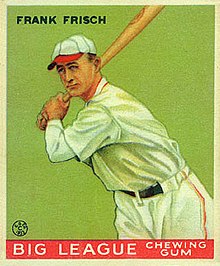Frankie Frisch
| Frankie Frisch | |||
|---|---|---|---|

Frankie Frisch, Chewing Gum
|
|||
| Second baseman / Manager | |||
|
Born: September 9, 1898 Bronx, New York |
|||
|
Died: March 12, 1973 (aged 74) Wilmington, Delaware |
|||
|
|||
| MLB debut | |||
| June 14, 1919, for the New York Giants | |||
| Last MLB appearance | |||
| August 5, 1937, for the St. Louis Cardinals | |||
| MLB statistics | |||
| Batting average | .316 | ||
| Hits | 2,880 | ||
| Home runs | 105 | ||
| Runs batted in | 1,244 | ||
| Managerial record | 1,138–1,078 | ||
| Winning % | .514 | ||
| Teams | |||
|
As player As manager |
|||
| Career highlights and awards | |||
|
|||
| Member of the National | |||
|
|
|||
| Inducted | 1947 | ||
| Vote | 84.47% (fifth ballot) | ||
As player
As manager
Frank Francis Frisch (September 9, 1898 – March 12, 1973), nicknamed The Fordham Flash or The Old Flash, was a German American Major League Baseball player and manager of the first half of the twentieth century.
Frisch was a switch-hitting second baseman who threw right-handed. He played for the New York Giants (1919–1926) and St. Louis Cardinals (1927–1937). He managed the Cardinals (1933–1938), Pittsburgh Pirates (1940–1946) and Chicago Cubs (1949–1951). He is a member of the National Baseball Hall of Fame and Museum and the St. Louis Cardinals Hall of Fame Museum.
Born in The Bronx, New York City, Frisch attended Fordham Preparatory School, graduating in 1916. He went on to Fordham University where he continued to star in four sports: baseball, football, basketball and track. His speed earned him the nickname "The Fordham Flash."
In 1919, Frisch left Fordham to sign with the New York Giants of the National League, moving directly to the majors without playing in the minor leagues. He made an immediate impact, finishing third in the NL in stolen bases and seventh in RBI in 1920, his first full season. Manager John McGraw was so impressed by Frisch that he soon named him team captain, giving him advice in baserunning and hitting. The Giants played Frisch at both third base and second base early in his career, but by 1923 he was installed as the team's full-time second baseman.
...
Wikipedia
